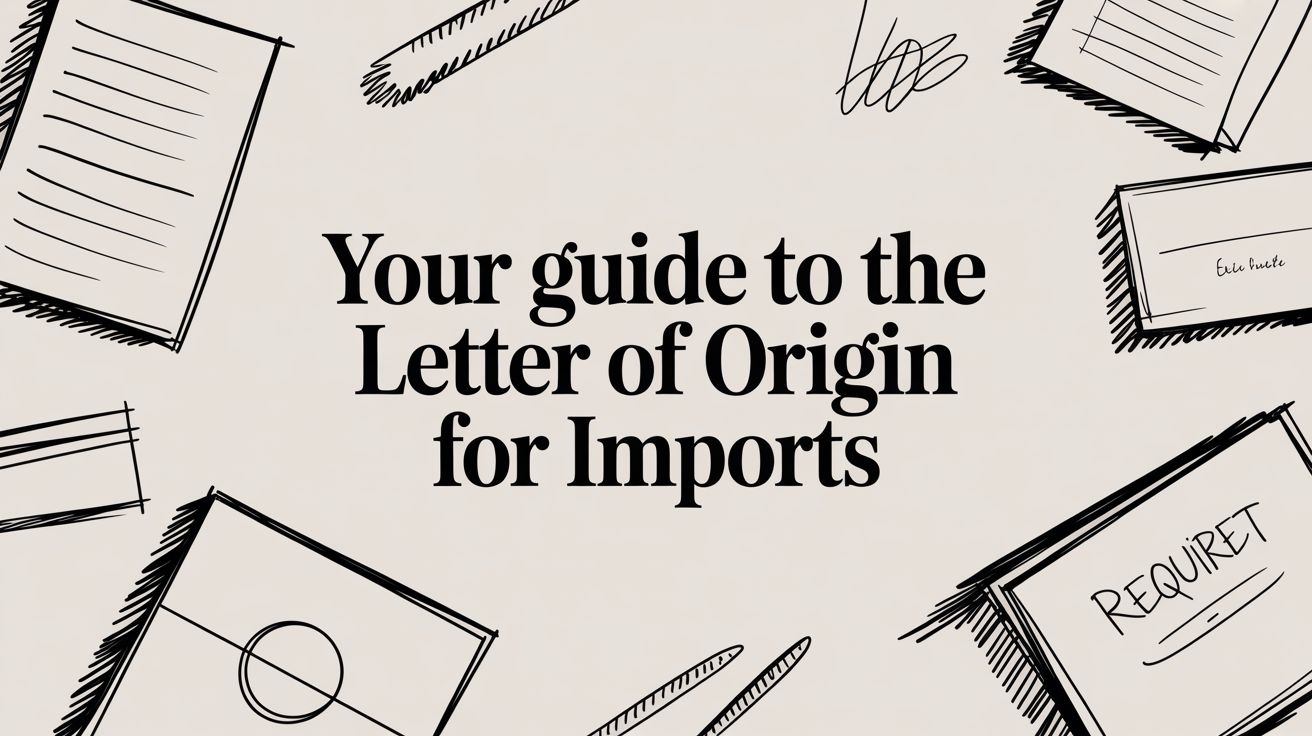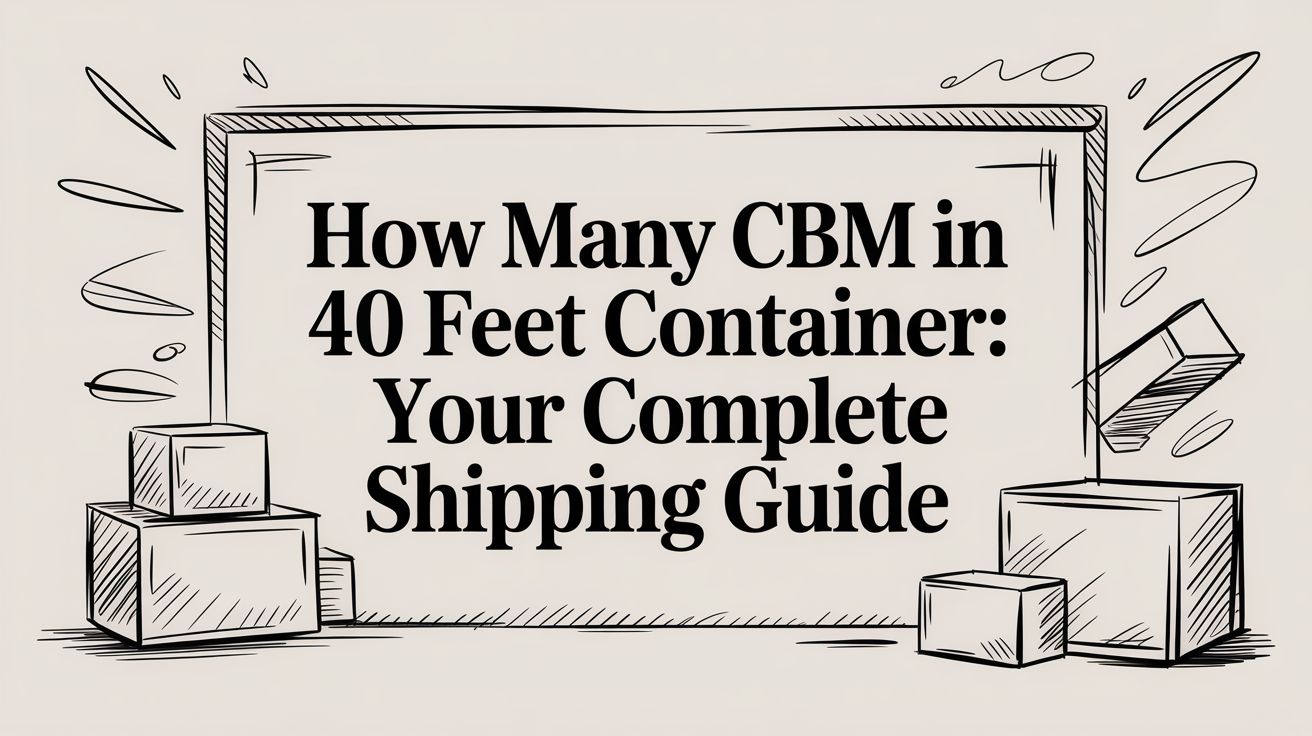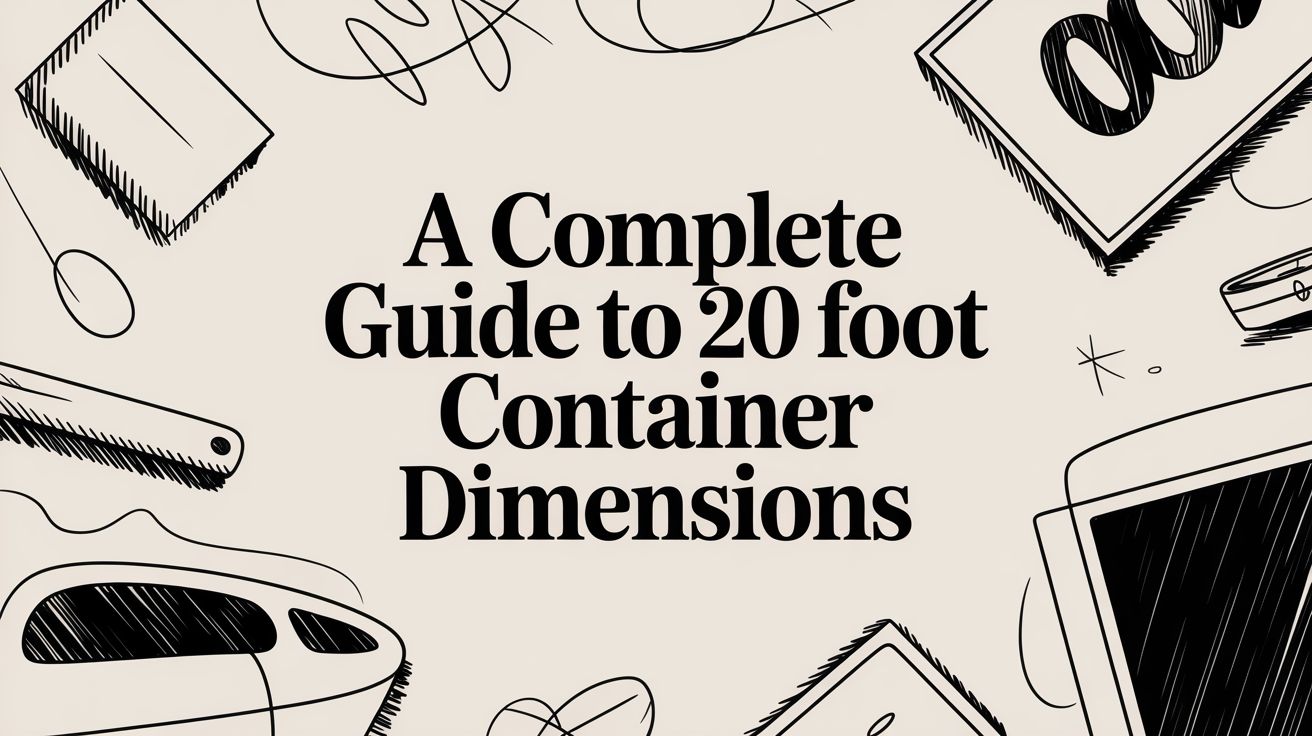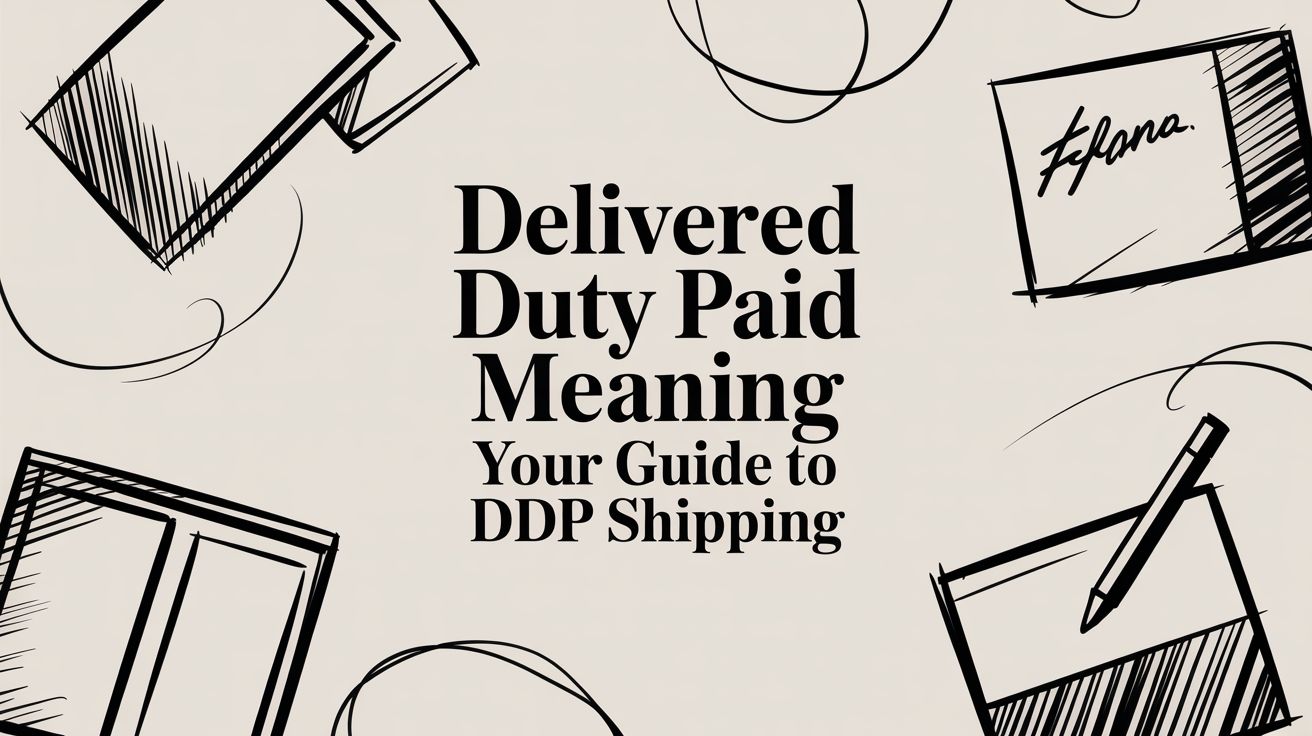When you're dealing with international shipping, one of the most fundamental documents you'll come across is the letter of origin. In the simplest terms, it’s a formal declaration stating the country where your goods were made, grown, or produced. Think of it as a passport for your products—it’s the official paperwork that tells customs authorities the nationality of your cargo.
What a Letter of Origin Actually Is
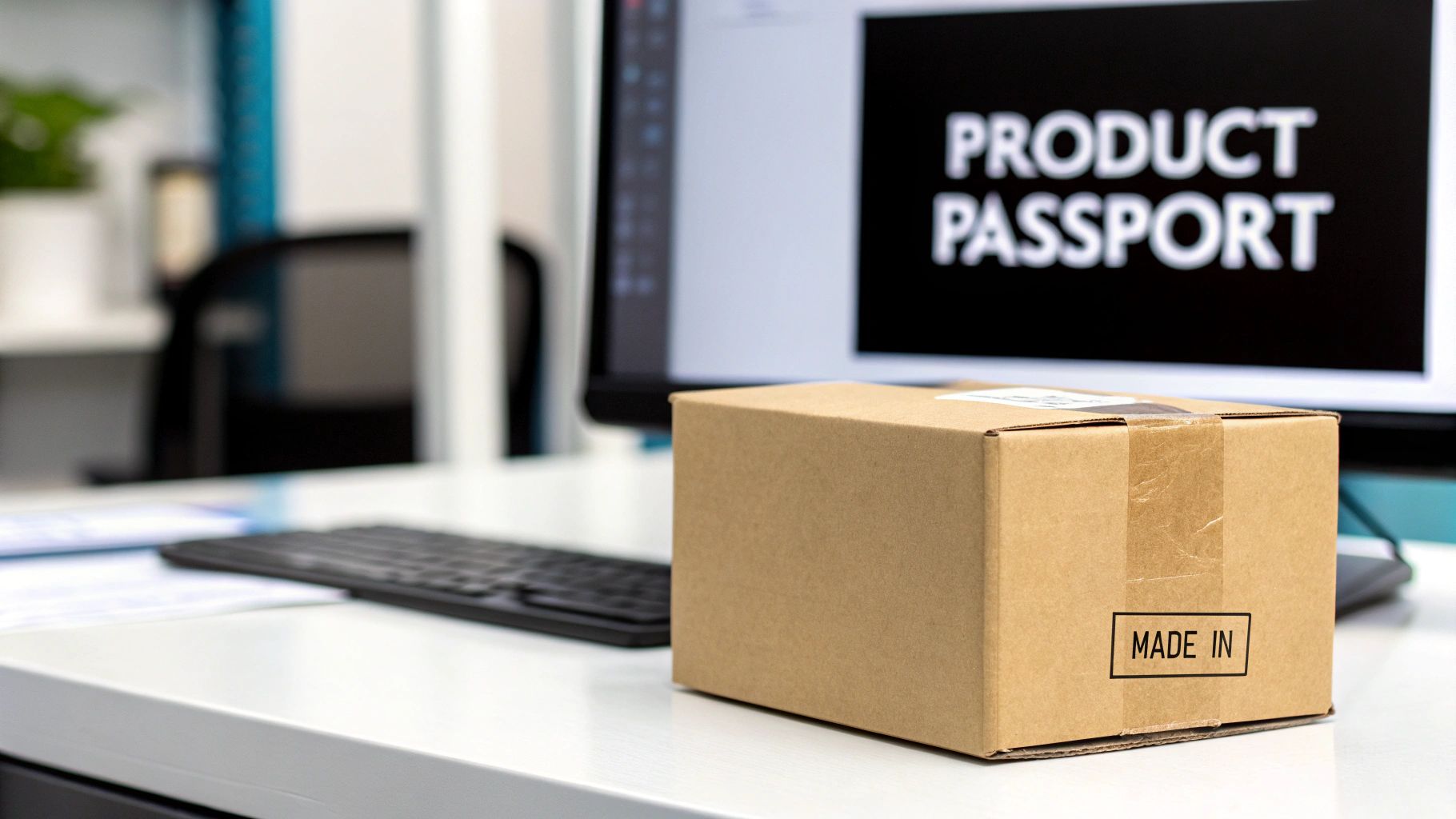
When your shipment arrives at its destination, customs officials need to know exactly where it came from. This isn't just a box-ticking exercise; the origin of your goods directly influences how they're processed and, crucially, how much you'll pay in duties and taxes.
Let's say you're importing a batch of custom-moulded plastic parts from a supplier in China. Without a letter of origin, the customs agency has no official proof of where they were manufactured. This kind of uncertainty is a red flag for them, often leading to frustrating delays, extra inspections, and even higher import duties because your goods can't qualify for any preferential trade terms.
The Core Purpose of This Document
At its heart, the letter of origin provides a clear, legally recognised statement about a product’s background. It’s not just paperwork for the sake of it—it serves several critical functions for both importers and customs authorities.
- Calculating Tariffs: This document is what customs officials use to apply the correct import duties. Depending on trade agreements, goods from certain countries might face lower (or higher) tariffs.
- Unlocking Trade Benefits: A letter of origin is your ticket to accessing the perks of Free Trade Agreements (FTAs). For example, if your goods originate from an FTA partner country, you could pay reduced or even zero duties.
- Confirming Import Eligibility: Some countries have restrictions or outright bans on products from specific nations. The letter of origin proves your shipment is compliant and can legally enter the country.
- Informing Trade Statistics: Governments rely on origin data to track trade flows, monitor economic trends, and shape future policies.
A letter of origin is the bedrock of smooth customs compliance. It’s the official proof that allows your goods to be properly classified, taxed, and legally cleared, helping you avoid costly assumptions and delays at the border.
To give you an idea of just how crucial this document is, consider the scale of operations in a major export country like China. Early this year, the national trade promotion system issued over 431,000 origin-related certificates in February alone. This staggering number shows just how baked into the global supply chain these documents are. If you're new to the lingo of global trade, our guide on freight forwarding terminology can help get you up to speed.
To quickly recap, here's a simple breakdown of what this document does for you as an importer.
Letter of Origin At-a-Glance
| Key Aspect | Primary Function and Importance |
|---|---|
| Origin Verification | Provides official, undeniable proof of where goods were manufactured or produced. |
| Tariff Determination | Allows customs to apply the correct duties and taxes based on the country of origin. |
| Trade Agreement Access | Essential for claiming preferential tariff rates under Free Trade Agreements (FTAs). |
| Regulatory Compliance | Ensures goods comply with import restrictions, quotas, or sanctions related to specific countries. |
| Customs Clearance | Prevents delays and potential penalties by providing clear, upfront information to authorities. |
Essentially, having a correct and validated Letter of Origin is non-negotiable for a smooth and cost-effective import process. It’s a small document that carries a lot of weight.
Letter of Origin vs. Certificate of Origin: What's the Real Difference?
When you're navigating the complexities of international trade, getting your paperwork right is everything. Two documents that frequently trip up even seasoned importers are the letter of origin and the Certificate of Origin (C/O). They sound almost identical, but in the eyes of customs officials, they're worlds apart.
Think of it this way. A letter of origin is like a friend giving you their word on something—it's a personal assurance. A Certificate of Origin, however, is like having that same statement notarised by a court official. One is a simple claim, while the other is an officially validated fact.
Breaking Down the Core Differences
So, what separates these two documents in practice?
A letter of origin is essentially a self-declaration. It's a straightforward statement, usually printed on the manufacturer's or exporter's company letterhead, asserting that the goods in a shipment were made in a particular country. Someone from the company signs it, and that's that. No outside body gets involved.
On the flip side, a Certificate of Origin is a formal, standardised document. The crucial part is that it isn't issued by your supplier. Instead, it comes from a recognised, independent third party. In China, this is typically the China Council for the Promotion of International Trade (CCPIT) or a local Chamber of Commerce. This official stamp is what gives the C/O its authority with customs agencies around the globe.
Let's put them side-by-side for a clearer picture:
| Feature | Letter of Origin | Certificate of Origin (C/O) |
|---|---|---|
| Issuer | The manufacturer, supplier, or exporter. | An authorised third party (e.g., Chamber of Commerce, CCPIT). |
| Formality | Informal; often a simple signed letter or statement on company letterhead. | Formal; follows a standardised, internationally recognised format. |
| Verification | Self-certified; no independent validation. | Officially verified and stamped by an authorised body. |
| Legal Standing | Limited legal weight; may not be accepted for official customs purposes. | High legal authority; required by customs for tariff calculations and compliance. |
Knowing When to Use Each Document
Getting this wrong can lead to serious customs headaches, so it's vital to know when each document is appropriate. The choice isn't yours or your supplier's to make—it’s dictated entirely by the importing country's rules for that specific product.
A simple letter of origin might pass muster in a handful of low-risk scenarios. Think internal company shipments or certain low-value B2B transactions where formal customs clearance isn't as stringent. But relying on one for a standard commercial import is a gamble you don't want to take.
The Certificate of Origin is the gold standard for virtually all international shipments. If you're hoping to get preferential tariff rates under a Free Trade Agreement (FTA), or if your goods are subject to quotas, a formal C/O isn't just recommended—it's mandatory. Trying to use a simple letter in these situations is a surefire way to get your shipment rejected, lose out on tariff benefits, and face costly delays.
For example, if you're importing products from China into a country like Thailand or Vietnam, you'll need a specific C/O called a Form E to benefit from the reduced tariffs under the ASEAN-China Free Trade Area. A basic letter from your supplier just won't cut it.
Before anything ships, your first step should always be to confirm the exact documentation needed with your freight forwarder or the customs agency in the destination country. Asking for the wrong document from your supplier is a surprisingly common misstep that can bring your entire supply chain to a screeching halt.
Why This Document Impacts Your Bottom Line
It’s easy to dismiss a letter of origin as just another piece of paper in the mountain of shipping documents. But thinking of it as mere admin is a huge mistake. This simple declaration is a powerful financial tool that directly impacts your landed cost, profitability, and even your competitive edge. Getting it wrong can turn a profitable import run into a very expensive lesson.
The biggest financial hit comes from its role in securing preferential tariff rates. Many countries have Free Trade Agreements (FTAs) specifically designed to boost trade by slashing or even eliminating import duties on goods from partner nations. Without a valid letter of origin, your products are just standard imports, slapped with the highest possible tariff rates.
Unlocking Tariff Savings with an FTA
Let’s put this into real numbers. Imagine you're importing £100,000 worth of electronics from China. The standard tariff might be 10%, which would cost you a cool £10,000 in duties.
Now, if a Free Trade Agreement is in place and your goods qualify, that rate could plummet to 0%. The only way to claim this massive saving is with an official document proving the goods genuinely originated in China.
- Without the right paperwork: You pay the full £10,000 duty.
- With a valid Letter of Origin: You pay £0 in duties.
That £10,000 difference goes straight back into your business. And this isn't a one-off perk; it's an advantage you can claim on every single shipment. This gives you the freedom to either lower your prices to grab more market share or simply enjoy much healthier profit margins.
This is especially true when importing from a manufacturing giant like China. The country's entire foreign trade system relies heavily on origin documents to apply these preferential treatments. China has 23 FTAs covering 30 countries and regions, and this trade accounts for roughly a third of its total foreign trade volume. If you fail to get the right letter of origin, you're essentially leaving government-approved savings sitting on the table. You can dive deeper into China's FTA partnerships and their specific document needs in this detailed overview of origin certificates.
Beyond Tariffs: Compliance and Quota Management
The financial story doesn't end with duty rates. Many countries use import quotas to protect their local industries, limiting the quantity of a specific product that can be brought in from certain nations. A letter of origin is the key piece of evidence that proves your goods belong under a specific country's quota.
On top of that, following international trade laws is simply not optional. Customs authorities use origin documents to enforce sanctions, anti-dumping duties, and other trade barriers. A missing or incorrect document can easily be seen as an attempt to get around these critical regulations.
The fallout from improper origin documentation is both severe and swift. Your shipment can be seized, you can be hit with hefty fines for non-compliance, and your company could be red-flagged for intense scrutiny on all future imports, creating a nightmare cycle of supply chain delays.
The High Cost of Small Mistakes
Let's walk through a real-world scenario. An importer brings in a container of textiles. The letter of origin they received has an HS code that doesn't match the one on the commercial invoice. It seems like a minor typo, but customs officials spot the discrepancy immediately.
What happens next is a domino effect of expensive problems:
- Shipment Seizure: The container is impounded at the port, going nowhere fast.
- Demurrage Fees: Port storage fees start racking up, often costing hundreds of pounds every single day.
- Customs Penalties: Fines are issued for the incorrect declaration.
- Production Halts: The delay throws your inventory into chaos, potentially stopping your production line or causing stockouts.
- Lost Sales: With no products to sell, you're losing revenue and your customers' trust.
What started as a simple clerical error has now spiralled into thousands of pounds in direct costs and missed opportunities. It’s a harsh reminder that a correct letter of origin isn’t just about saving money—it’s about protecting your entire supply chain and business reputation from crippling financial and logistical blows.
How to Secure Your Letter of Origin from China
Getting the right letter of origin from your Chinese supplier isn't about crossing your fingers and hoping for the best. It's a clear, methodical process. When you get this right from the start, you sidestep frustrating customs delays, dodge unexpected fees, and make sure your goods qualify for any available tariff reductions.
This playbook will walk you through the entire process, step-by-step, so you can handle your shipping documents like a seasoned pro. The real work begins long before your goods are even packed—it starts with your very first conversations and needs to be locked into your contracts.
Specify Your Needs in the Purchase Order
Think of your purchase order (PO) as the foundational legal document for your entire deal. It's the perfect place to formally lay out exactly what documentation you need. Never assume your supplier already knows; being vague at this stage is a recipe for incorrect or missing paperwork down the line.
You need to be crystal clear in your PO about the specific type of origin document you require.
- Official Certificate of Origin: If you need a formal C/O for customs or to claim benefits under a Free Trade Agreement (FTA), you must specify that it has to be issued by an authorised body like the China Council for the Promotion of International Trade (CCPIT).
- Manufacturer’s Declaration: On the other hand, if a simple letter of origin on your supplier's company letterhead is all you need, state that plainly.
- Specific FTA Forms: If you're importing under a specific agreement, such as the Asia-Pacific Trade Agreement (APTA), call out the exact form needed (for example, Form B).
Putting this in writing from day one sets clear expectations and makes providing the correct paperwork a non-negotiable part of the deal. The infographic below really drives home how having a valid document can directly boost your profits by cutting down on tariffs.

As you can see, the right paperwork kicks off a chain reaction that positively impacts your bottom line, unlocking some serious cost savings.
Confirm Supplier Capability and Provide Information
Once you've laid out your requirements, the next logical step is to make sure your supplier can actually deliver. Not every factory is experienced with the bureaucracy of getting official certificates from bodies like the CCPIT.
Ask them point-blank if they have a process for this. A great way to vet them is to ask for a sample of a certificate they've secured for another client. This lets you check their work for quality and accuracy.
After you're confident they can handle it, you need to arm them with all the necessary details to fill out the document correctly. They’ll need specifics from you, including:
- Full Consignee Details: Your company’s complete legal name, address, and contact info, exactly as it should appear on every shipping document.
- Accurate Product Descriptions: Don't be vague. Provide detailed and clear descriptions of your goods.
- Correct HS Codes: The specific Harmonized System codes for every product in the shipment.
- Port of Loading and Destination: Name the exact ports your shipment will travel between.
- Vessel/Flight Information: If you have it when they apply for the document, provide it.
Giving them this information in a clear, written format helps you avoid typos and other transcription errors on their end. A critical part of this is ensuring the document's validity, which often involves the use of digital signatures for authenticity to satisfy international customs standards.
Review the Draft Before Shipment
Here’s a rule to live by: never let a letter of origin be finalised without your eyes on it first. Always ask your supplier for a draft copy—a scanned PDF is perfectly fine—before the goods are scheduled to leave the port. This is your final and most important chance to catch mistakes that could end up costing you a lot of time and money.
When you get the draft, meticulously check every single detail against your commercial invoice, packing list, and bill of lading. Pay close attention to:
- Spelling of all company names and addresses.
- Consistency in product descriptions and HS codes across all documents.
- Matching quantities, weights, and invoice numbers.
Pro Tip: One of the most common errors we see is a mismatch between the exporter listed on the Certificate of Origin and the shipper named on the Bill of Lading. These details have to line up perfectly, or you risk your shipment getting flagged by customs for a lengthy inspection.
This level of scrutiny is absolutely essential. To give you an idea of the scale, in a major export hub like Zhejiang Province, Yiwu Customs alone issued 2,626 APTA Certificates of Origin in just the first six months of a recent year. That highlights the sheer volume and critical importance of these forms.
By following these steps, you shift from scrambling to fix problems after they happen to proactively managing your documentation. This ensures all your shipments—whether they're small parcels or entire containers of freight by sea—move through customs smoothly and efficiently.
Common Mistakes That Cause Customs Delays
A tiny, seemingly harmless error on a Letter of Origin can snowball into a massive headache, bringing your entire shipment to a dead stop. These aren't just minor clerical issues; they're costly blunders that can get your goods stuck, fined, or flat-out rejected at the border. Getting a handle on these common pitfalls is your first line of defence.
One of the biggest culprits we see is mismatched information across shipping documents. You have to remember, customs officials are detectives. They meticulously cross-reference every single detail on the Letter of Origin against the commercial invoice, the packing list, and the bill of lading.
If the product description on your origin document says one thing but the invoice says something slightly different, or if the HS codes don't line up perfectly, that's an instant red flag. It screams "potential misdeclaration" to an inspector, which is often an invitation for a full-blown physical inspection of your cargo and a long, frustrating delay.
Inaccurate HS Codes and Descriptions
The Harmonized System (HS) code is the universal language for classifying products in global trade. Nailing this code is crucial. Getting it wrong on your Letter of Origin can mean you end up paying the wrong tariff—either overpaying and losing money, or worse, underpaying and getting hit with penalties.
Imagine your supplier lists a shipment of highly specific electronic parts simply as "Computer Parts." The correct, more detailed HS code likely has a different duty rate. When customs spots that discrepancy, they don't just fix the paperwork. They'll probably hold your entire shipment to figure out what's really inside.
The rule of thumb is simple: absolute consistency is non-negotiable. Every single piece of data, from the consignee’s address to the net weight of the goods, must be a perfect mirror across all your shipping documents. A single typo can invalidate the entire set.
The best way to sidestep this is to build a rock-solid verification process before anything leaves the factory. Create a checklist and go through the draft Letter of Origin with a fine-tooth comb, comparing it against all the other finalized documents before you give the green light.
Using an Unauthorised or Invalid Issuer
Another classic mistake is getting the document from the wrong source. A simple manufacturer's declaration—a basic Letter of Origin—might seem good enough, but many countries and trade agreements are sticklers. They require an official Certificate of Origin issued by an authorized body. In China, that's almost always the China Council for the Promotion of International Trade (CCPIT).
Trying to slide by with a self-declared letter when an official certificate is needed is a surefire way to get your shipment stopped in its tracks. Customs will immediately reject any claims for lower tariffs and will likely hold your goods hostage until you can produce the correct, officially stamped document. That can take days, even weeks, all while expensive storage fees are piling up at the port.
To avoid this costly trap, you need to:
- Verify Requirements: Before you even place an order, confirm exactly what kind of origin document the destination country’s customs authority demands.
- Vet Your Supplier: Make sure your supplier actually knows how to get official certificates from bodies like the CCPIT. Don't be shy—ask for samples of past certificates they've successfully obtained.
It all boils down to clear communication and meticulous records. Every document, from the Letter of Origin to the final cargo manifest, has to be perfect. For a better picture of how all these papers fit together, take a look at our guide on the Import General Manifest and its critical role. A strong documentation strategy isn't just paperwork; it's your best insurance against crippling customs delays.
How a Good Freight Forwarder Makes Documentation Headaches Disappear
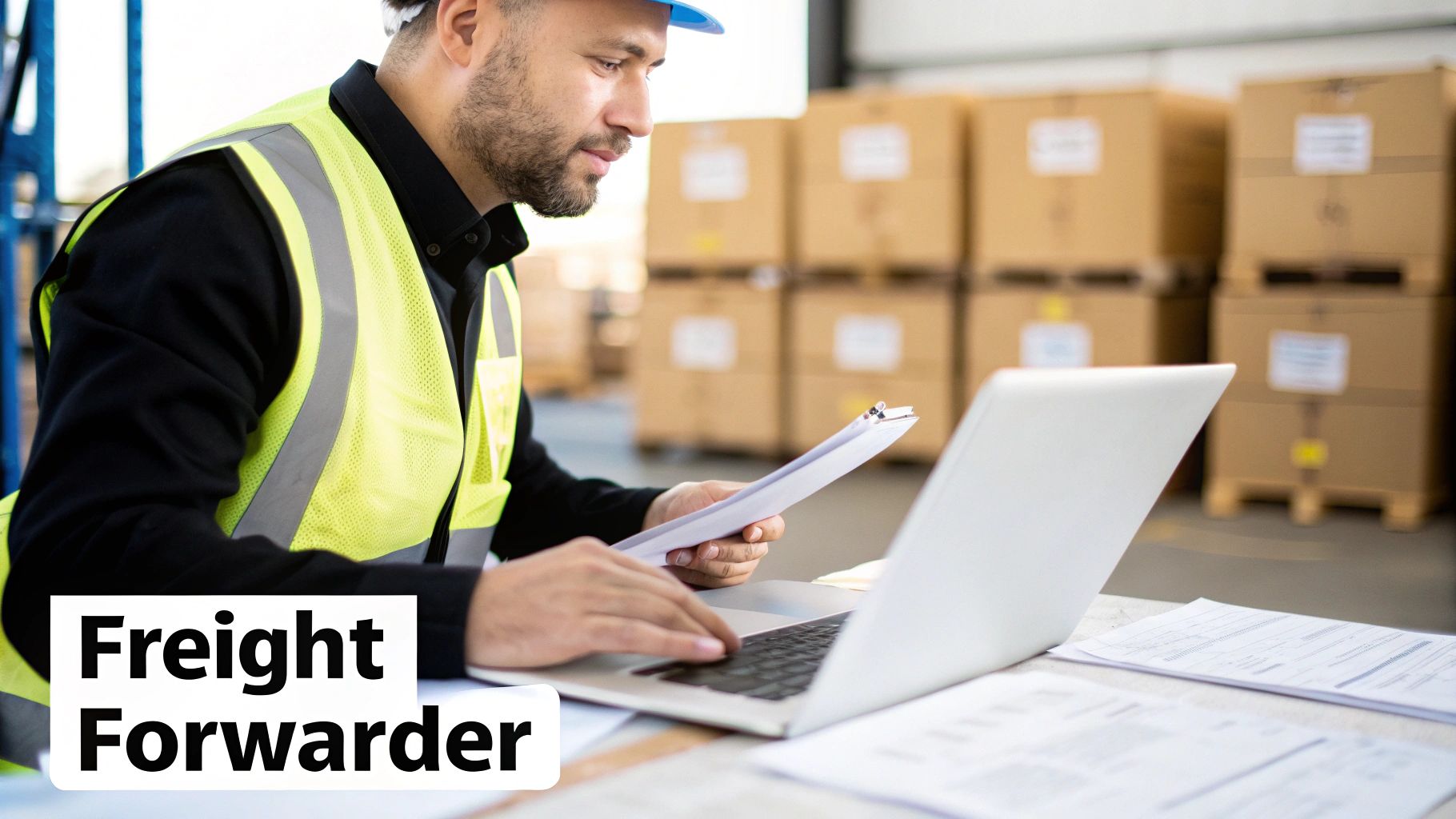
Let's be honest, trying to manage the mountain of international trade paperwork can feel like a full-time job. It pulls you away from what you should be doing: growing your business. This is precisely where a freight forwarder like Upfreights steps in, acting as far more than just a logistics provider. They become your compliance partner.
A good forwarder takes the entire puzzle of securing a valid letter of origin off your plate. You don't need to become a customs expert overnight because they already are.
Think of them as your boots on the ground in China. Instead of you trying to chase down a supplier from thousands of miles away, your forwarder is right there, working with them directly. They make sure the correct origin document is prepared properly from the start, catching the small mistakes that can cause massive delays down the line.
Vetting and Coordinating Before Problems Start
The real magic of a freight forwarder happens before your cargo ever gets on a ship. They don't just move boxes; they meticulously manage the paperwork. Your forwarder will get a draft of the letter of origin and check it against the commercial invoice and packing list long before anything is finalised.
This expert review is worth its weight in gold. They are trained to spot the tiny inconsistencies you might easily overlook—a slightly off HS code, a typo in the consignee's address. Catching these errors at the source can save you from excruciating customs holds and unexpected fines.
Your freight forwarder is your first line of defence against documentation errors. By finding and fixing mistakes at the factory in China, they stop problems from ever reaching your destination port, protecting your timeline and your bottom line.
And what if you need an official Certificate of Origin from an authority like the China Council for the Promotion of International Trade (CCPIT)? Your forwarder handles that, too. They’ll work with both your supplier and the issuing body to make sure the application is smooth and quick, removing a huge administrative headache from your to-do list.
Making the Whole Process Flow Smoothly
The value a forwarder brings goes well beyond a simple document check. They orchestrate the entire flow of information, ensuring every document is accurate, consistent, and filed right on time.
Here's what that typically looks like in practice:
- Supplier Communication: They speak the language—literally and figuratively. They clearly communicate your documentation needs to the factory, cutting through any potential language or cultural confusion.
- Document Cross-Check: Your forwarder will painstakingly ensure the letter of origin matches every other shipping document. This isn't just good practice; it's a non-negotiable for customs.
- Liaising with Authorities: If official certificates are needed, they manage the entire submission process, making sure all the i's are dotted and t's are crossed.
- Digital Filing: They handle the electronic submissions required for modern customs clearance, which makes the whole process faster and more efficient.
When you trust this critical task to an experienced freight forwarder, you're essentially outsourcing the risk and the hassle. It frees you up to focus on what you do best—running your business—while they keep your supply chain moving without a hitch. A reliable partner turns a paperwork nightmare into just another simple step in the journey.
Frequently Asked Questions
Getting the paperwork right for international shipping can feel like navigating a maze. When it comes to a letter of origin, a few key questions pop up time and time again. Let’s clear up the confusion and tackle some of the most common queries importers have.
Can My Supplier Just Write a Simple Letter Stating the Origin?
It's a tempting shortcut, but the answer is almost always no. While a simple supplier declaration, sometimes called a manufacturer's letter of origin, is better than nothing, it rarely holds up for official customs clearance. Most customs bodies around the world need a formal Certificate of Origin (C/O), which is a standardised document issued by an authorised chamber of commerce.
In China, this is typically the China Council for the Promotion of International Trade (CCPIT). A basic letter from your supplier just doesn't have the official stamp and verification that gives a proper C/O its legal weight.
Think of it this way: if you're trying to get reduced or zero tariffs under a Free Trade Agreement, an official, standardised certificate (like a Form E for trade with ASEAN countries) is non-negotiable. Trying to pass with an informal letter is a huge risk that will likely end with you paying much higher duties. Always check what specific documents your destination country requires.
How Long Does It Take to Get a Letter of Origin in China?
This really depends on what you're asking for. A simple manufacturer’s declaration on company letterhead? Your supplier can probably type that up in a few minutes.
But if you need an official Certificate of Origin from an authority like the CCPIT, you're looking at a more formal process. Once your supplier submits a perfect application, it usually takes one to three business days to get the certificate issued. Any errors, mismatched details, or information that needs extra checking will cause delays. It's crucial to ask your supplier for this document well before your cargo is scheduled to leave port.
What Happens If the Information on the Letter of Origin Is Wrong?
This is where things can get messy—and expensive. Customs officials are meticulous. They cross-check the details on the letter of origin against the commercial invoice, packing list, and bill of lading. Any discrepancy, no matter how small, is a massive red flag.
The fallout from a mistake can be serious:
- Shipment Delays: Your container gets stuck at the port while officials investigate, leading to storage fees and production delays on your end.
- Financial Penalties: You can be hit with hefty fines for providing inaccurate information.
- Loss of Tariff Benefits: The preferential duty rate you were counting on? Gone. You'll be forced to pay the highest standard tariff.
- Cargo Seizure: In the worst-case scenario, particularly if it looks like intentional fraud or is a repeat offence, customs can seize your goods outright.
Always, always review the draft document before the final version is issued. Double-check everything—HS codes, product descriptions, quantities, and consignee details. Getting it right isn't just a good idea; it's essential for a smooth import process and protects you from costly headaches down the line.
